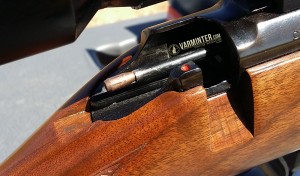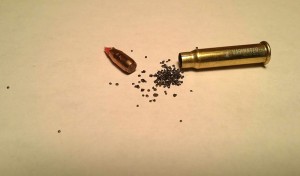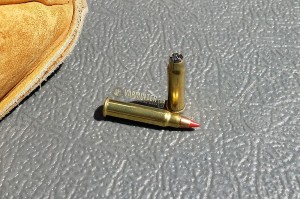Many of us are aware of what can happen to old .17HMR ammunition, but for those that don’t, I wanted to relay an experience that happened to me the other day. I was testing the new CCI A17 – .17HMR ammunition, and wanted to compare it to some of the first year Hornady branded .17HMR ammunition. As I was shooting some rounds through my chronograph, I heard an odd crack and realized that I had some type of misfire, or perhaps a squib. I kept the rifle pointed in a safe direction, dropped the magazine, then slowly pulled out my bolt. As the bolt came out, I saw that the case was cracked at the neck, the bullet was gone, and the powder was jammed all the way at the top of the cartridge.
Powder stuffed at the top of the case (click to make image larger):
Unfortunately for me, that meant the bullet was stuck up in my barrel. I grabbed my .17 caliber cleaning rod and removed the jag. Then, I carefully fed the rod into the barrel from the muzzle end. Once I felt the bullet, I realized it was stuck about two inches up from the chamber. It took a few raps, but the bullet then came out of the barrel, stuck in the tip of the rod (it’s a spare rod I keep on hand just for these types of events).
The bullet, as it came out of the barrel. You can see the rifling on the bullet from where it wedged into the barrel (click on image to make larger):

The bullet, as it came out of the barrel. You can see the rifling on the bullet from where it wedged into the barrel
Lessons to be learned for those who have not experienced this:
- Always pay attention to the sound of your round when you pull the trigger. Had I fed another bullet in and pulled the trigger, I might be typing this with one hand.
- Be careful with older .17HMR ammunition. This ammo is at least 12 years old and most likely already began to develop cracks in the neck, while still sitting in the original, sealed, box.
- Carry some type of cleaning rod with you at all times (I prefer one-piece). Most of my day was spent shooting this rifle for groups and running strings through the chronograph. If I did not have this rod in my truck, my day with this rifle would have been over.
- Wear hearing, eye and, whenever possible, hand protection.
I’m not saying, don’t shoot your old .17HMR, or .17HM2 (.17 Mach2) ammunition. Just inspect it before shooting it. If you have visible cracked necks, just remove those from your supply. The annealing process (the process of heating metal and allow it to cool slowly, in order to remove internal stresses and toughen it) has improved since 2003, and I have had discussions with one of the major ammunition manufacturers and they have stated that new .17HMR ammunition being produced today, has a much better lifespan then the old ammunition. What it all comes down to is this, be careful when shooting old 17 HMR ammunition, follow the steps laid out above if you run into a problem, and do a quick inspection of your ammunition.
— EM
- Podcast with Soul Seekers Nation From the 2025 SHOT Show - February 17, 2025
- Complete Overview of the .17-5.56 KAK Cartridge by KAK Industry - July 21, 2024
- AGM Global Announces New and Upgraded Optics at the 2024 SHOT Show - February 1, 2024




